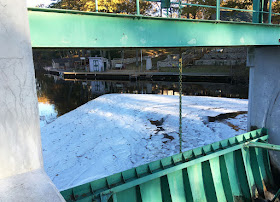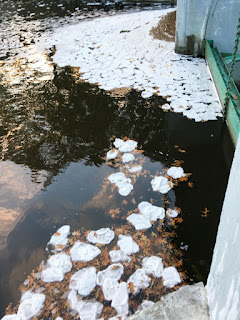Lake Margrethe is a 1,920-acre lake in Crawford County, just west of Grayling, where PFAS contamination is under investigation in connection to the Camp Grayling Michigan National Guard base there.
In Grayling, filters have been provided to about 175 homes near the Grayling Army Airfield and another 35 homes around Lake Margrethe. The state is telling residents that it needs to decide if more homes need the filters and notes that no long-term safe water solution has been determined yet because the city's municipal supply is also contaminated.
The military, meanwhile, is following a linear, drawn-out investigation process in Grayling and other bases that's likely to delay any actual cleanup by years.
As time goes by, affected residents continually learn more about contaminants that few had ever heard of before last year.
Because PFOS is a surfactant, a chemical microlayer on the water surface gets sudsy when wind conditions are right.
The foaming has also been observed on Lake Margrethe in Crawford County, where the DEQ is also conducting a PFAS plume investigation at the Camp Grayling Michigan National Guard base. The DEQ took foam samples from the lake late last year.
"It's different than the foam you'd see on disturbed water," Bush said, describing it as whiter and frothier. "It's like Mr. Bubbles suds."
========================================
Firefighting chemical linked to water safety concerns
By Jeremy Wahr
September 7, 2018
By JEREMY WAHR
Capital News Service
LANSING, MI —
A firefighting foam has been linked to a group of chemicals known to be harmful to infants, toddlers and pregnant women. But it is still kept on hand because firefighters say they don’t have effective alternatives.
Detection of the chemicals, known as PFAS, has led to the creation of the Michigan PFAS Action Response Team, a multi-agency organization dedicated to understanding the far-reaching effects of the chemical and educating the public on the threat it poses.
“It’s reason for concern because it’s an issue of public health,” said Katie Parrish, communications director for the Michigan League of Conservation Voters.
The Michigan PFAS Action Response Team has asked State Fire Marshal Kevin Sehlmeyer to survey over 1,000 fire departments to identify the amount of PFAS in firefighting foam, according to the Michigan Department of Licensing and Regulatory Affairs.
Although the survey has not been completed, the response team and other agencies have evidence of the dangers of the foam used to contain fuel and electrical fires and in training drills.
Firefighters and certain military personnel are required to use the foam. The response team believes the military’s heavy use of it contributed to elevated levels of the chemicals in Lake Margrethe, a lake adjacent to Camp Grayling. About a dozen similar sites are also affected.
Because of the danger, many newer firefighting foams don’t contain PFAS, said David Glotzbach, president of the Michigan Association of Fire Chiefs and a 33-year veteran firefighter.
“However,” Glotzbach said in an email, “these products are not effective in extinguishing flammable liquid fires.”
The Department of Environmental Quality has 35 active investigations for potential PFAS contamination across the state. It has begun testing public drinking water for the contaminant throughout the state, said Scott Dean, the agency’s communications director.
The testing will be finished by the end of the year and the agency has only found one public drinking supply – in Parchment – with dangerous levels of the chemical, he said.
Some commercial businesses have fought the testing. In May, the managers of Gerald R. Ford International Airport attempted to deny DEQ testing, claiming government overreach. The DEQ eventually tested the airport and found elevated levels of the chemical.
PFAS is dangerous in part because it does not break down in the environment or the human body, leading to its designation as a “forever chemical” by the Michigan League of Conservation Voters.
The chemical is produced across the country and used not just for firefighting but for products such as stain-resistant shoes and no-stick pans. Waste from these production sites cannot always be treated by generic wastewater treatment plants, according to the Michigan Environmental Council. Specifically, when several industrial buildings discharge waste directly into a treatment plant, the chemicals will still survive.
Meghan Swain, executive director of the Michigan Association for Local Public Health, says the federal government should be more proactive in regulating PFAS.
“Michigan is the only state talking about PFAS chemicals,” Swain said referring to the formation of the state’s PFAS Action Response Team. “The EPA should have sounded the alarm years ago.”
The EPA says 70 parts per trillion is the limit on PFAS for safe drinking water. But some groups, such as the Michigan League of Conservation Voters, say that it is too lenient.
“The state is using the EPA’s standard but it’s critical to understand that this EPA standard is an unenforceable, advisory-only recommendation and only covers two of the many PFAS chemicals,” Parrish said.












